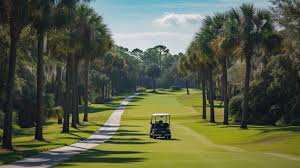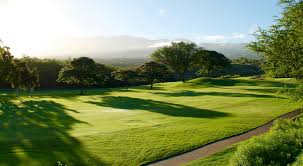
Chinch Bugs vs. Sod Webworms: Spotting the Difference in Your Florida Lawn
Whether you’re a new homeowner in Florida or a long-time resident, you already know that conditions in the Sunshine State…

For golf course managers in Florida, selecting and maintaining the right type of grass isn’t just about aesthetics – it’s about creating the perfect playing surface that can withstand our unique climate while delivering exceptional playability. With decades of experience serving Florida’s premier golf courses, we’ve learned exactly what works and what doesn’t in our challenging subtropical environment.
Golf course grass selection is one of the most critical decisions affecting both playability and maintenance requirements. The main types found on courses across the country each bring their own unique characteristics and challenges.
Bermuda grass varieties dominate southern courses, offering exceptional heat tolerance and durability.
Bentgrass, traditionally favored in northern regions, provides incredibly smooth putting surfaces but struggles in extreme heat.
Zoysia has been gaining popularity as a middle-ground option, offering excellent density and drought resistance while requiring fewer inputs than other varieties.
Annual Ryegrass plays a crucial role in southern courses as an overseeding option during cooler months, while Poa Annua, though often considered a weed, has become an accepted and even celebrated grass type on some prestigious courses.
Each of these grasses interacts differently with golf balls, requiring players to adjust their strategy and technique accordingly.
In Florida’s demanding climate, Bermuda grass has proven itself time and again as the undisputed champion of golf course turf. The reasons for this dominance are compelling: Bermuda grass demonstrates remarkable drought tolerance, making it ideal for our often-dry periods, while its ability to thrive in full sun conditions matches perfectly with Florida’s sunny climate. Perhaps most importantly for golf course applications, Bermuda’s rapid recovery rate ensures that heavily trafficked areas can maintain their playability even under intense use.
We’ve worked with numerous courses across southern Florida, and consistently find that Bermuda varieties excel when cut low and tight, creating the smooth, firm, and fast playing surfaces that both professionals and amateurs prefer.
Among the most successful Bermuda cultivars we’ve implemented, Celebration has shown outstanding drought tolerance and wear resistance. TifWay 419 continues to be a reliable choice for fairways, while Latitude 36 offers improved cold tolerance for courses in northern Florida. For putting greens, Tif Eagle and TifDwarf have proven themselves exceptional choices, providing the ultra-smooth surfaces required for championship play.

The impact of grass type on golf play cannot be overstated. Bermuda grass, the dominant variety in Florida, creates unique playing conditions that skilled players learn to master. Its notable grain – the direction in which the grass grows and leans – creates a fascinating dynamic on putting greens. When viewed from different angles, Bermuda appears darker in one direction and glossier in another, giving observant players valuable information about how their putts will break and roll.
The density of Bermuda grass creates a slightly springy surface that requires players to adjust their shot power, particularly on approach shots and chips. This characteristic can be especially challenging for players accustomed to northern grasses, as shots that might check quickly on bentgrass will often release further on Bermuda.
Bentgrass, while less common in Florida, offers a distinctly different playing experience. Its finer texture and more vertical growth pattern typically result in faster putting surfaces with less grain influence. However, these characteristics make it particularly challenging to maintain in our climate, which is why it’s rarely seen on Florida courses.
Poa Annua, which often invades courses naturally, presents its own unique challenges. Its tendency to grow at different rates throughout the day can create subtle bumps and inconsistencies on putting surfaces. While this might frustrate some players, others, particularly those who grew up playing on Poa Annua greens, have learned to read and adapt to these subtle variations.
The strategic use of different grass types across a golf course isn’t just about aesthetics – it’s about optimizing each area for its specific purpose and play requirements. Putting greens demand the highest level of precision and consistency, which is why we typically recommend dwarf Bermuda varieties like TifEagle or TifDwarf for these crucial areas. These specialized cultivars can handle extremely low mowing heights while maintaining density and smoothness that’s essential for true ball roll.
Fairways present their own unique challenges, requiring grass that can withstand frequent mowing, heavy traffic, and various weather conditions while still providing an optimal playing surface. Standard Bermuda varieties excel here, offering the perfect balance of durability and playability. The slightly higher cut height on fairways allows for better wear resistance while still maintaining the firm, fast conditions that modern players prefer.
Rough areas serve a distinct purpose in golf course strategy and require careful consideration in grass selection. These areas need to:
The decision to switch grass cultivars is significant and shouldn’t be taken lightly. Throughout our years of working with Florida golf courses, we’ve identified several key situations that warrant a cultivar change. Environmental shifts can render previously successful varieties less effective – we’ve seen this particularly in coastal areas where changing salt levels affect turf performance. Sometimes, newer cultivars simply offer superior characteristics that justify the switch, such as better disease resistance or improved drought tolerance.

Consider changing your course’s grass cultivar when:
Florida’s climate creates perfect conditions for various turf pests, with mole crickets and grub worms presenting the most significant challenges to golf course managers. These persistent pests require a sophisticated, year-round management approach. We’ve found that successful pest control requires a combination of preventive and reactive measures, carefully timed throughout the season.
Mole crickets pose a particular challenge because they damage grass both through their feeding and their tunneling activity. Our recommended approach combines monitoring with a strategic application of both systemic and contact insecticides. Early detection through regular scouting is crucial – we teach our clients to look for signs of damage early in the season when control measures are most effective.
Fungal diseases in Florida golf courses follow distinct seasonal patterns that experienced managers learn to anticipate and prevent. During the fall and winter months, we see particular challenges with anthracnose, dollar spot, and large patch. These diseases thrive in the cooler, more humid conditions typical of our mild winters. Prevention becomes critical during these periods, and we strongly advocate for the use of predictive tools like Syngenta Greencast to anticipate disease pressure.
Spring and summer bring a different set of fungal challenges:
Proper topdressing represents one of the most crucial yet often overlooked aspects of golf course maintenance. This practice involves far more than simply spreading sand or compost over your turf. When done correctly, topdressing gradually improves soil structure, enhances drainage, and creates more consistent playing surfaces throughout your course.
Our favorite topsoil is definitely the Comand brand. It’s fertilizer ban-compliant and a great product that our clients love. Before you get into your program, you want to be sure you’re starting with the best products.
We recommend implementing a comprehensive topdressing program that includes:
The path to maintaining exceptional golf course turf in Florida requires a deep understanding of our unique climate, soil conditions, and the specific challenges each grass variety presents. Through our extensive experience at Council Oxford, we’ve helped courses across southern Florida achieve and maintain championship-quality playing surfaces year-round. Success comes from not just choosing the right grass types, but implementing comprehensive maintenance programs tailored to your specific conditions.
We understand that every course has its own unique set of challenges and goals. That’s why we offer customized consulting services to help you optimize your turf management strategy. Whether you’re considering a cultivar change, battling persistent pest issues, or simply looking to improve your current maintenance practices, our team of experts can help.
Contact our team at Council Oxford for a consultation tailored to your course’s specific needs. Our agricultural specialists understand the unique challenges of Florida golf courses and can help you achieve and maintain championship-quality turf year-round.
